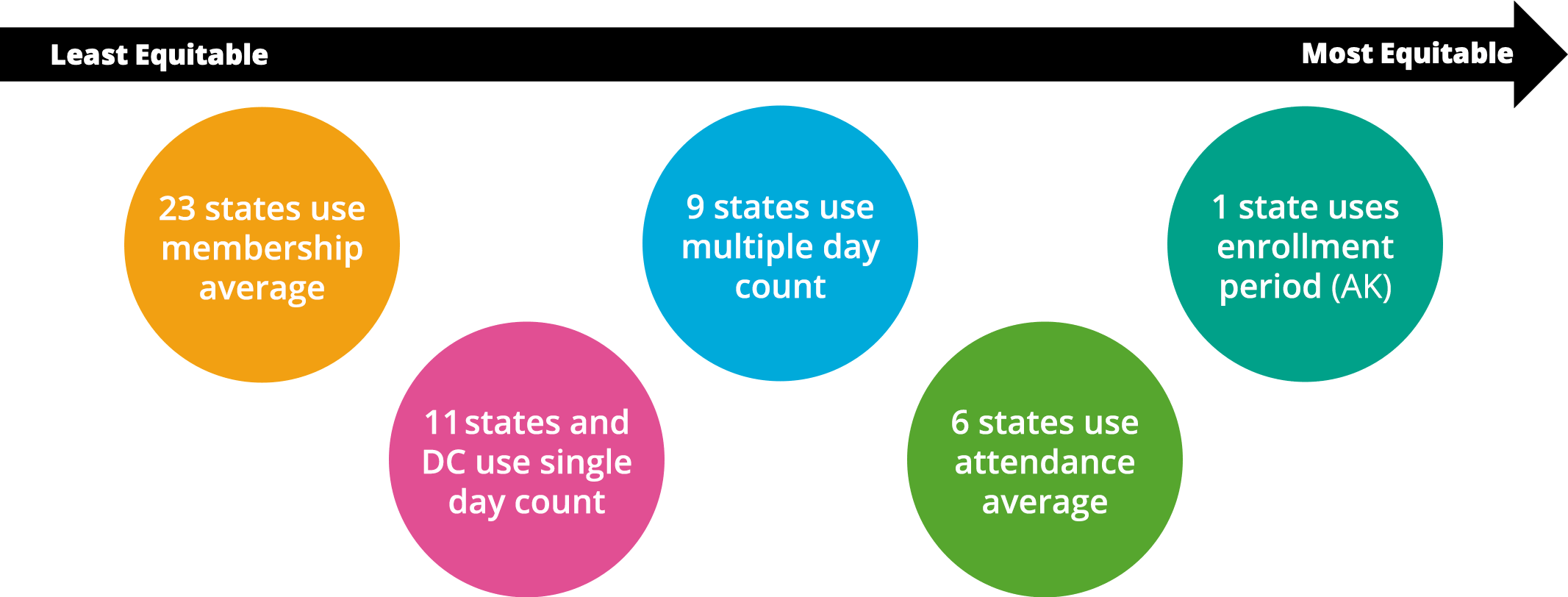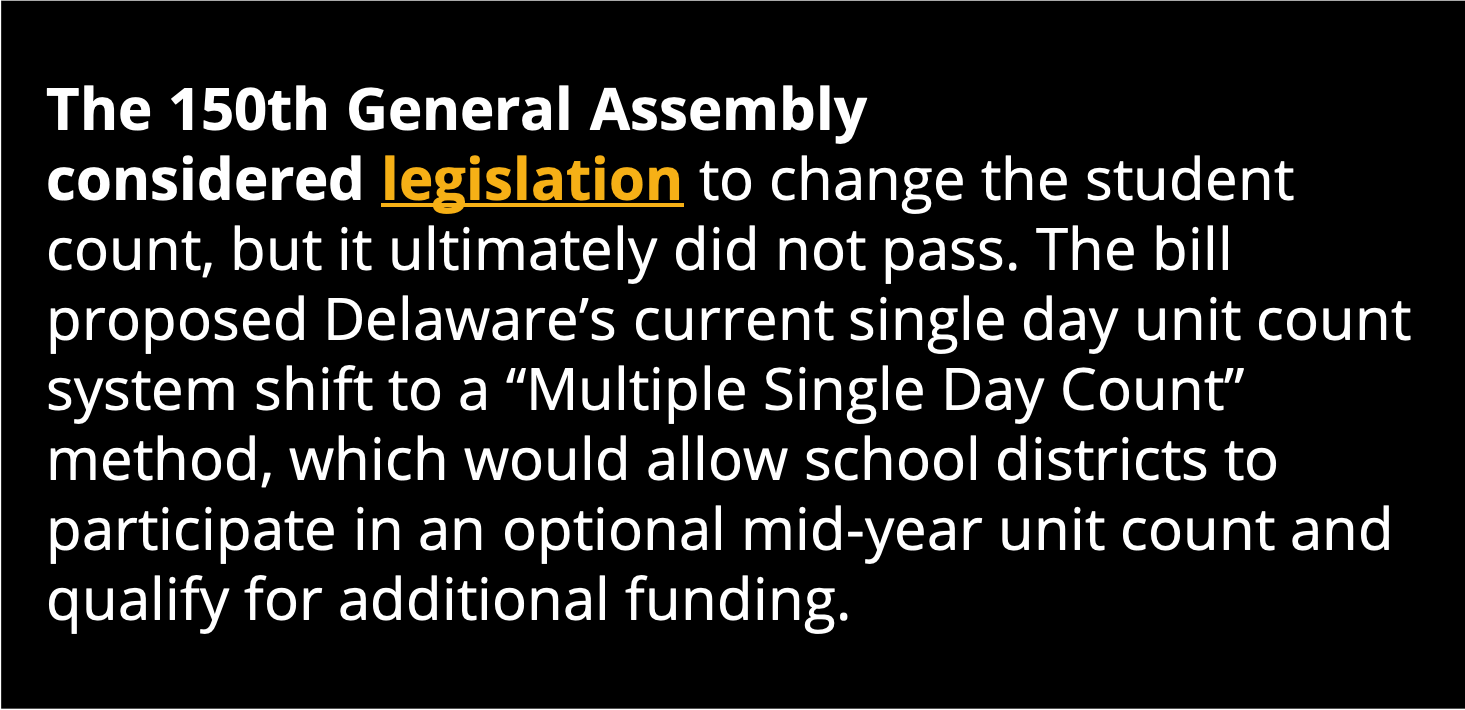Modernizing Delaware's School Funding System
Introduction
- Delaware is at a historical crossroads. Right now, state leaders have the opportunity to strike down decades of systemic inequity by revamping Delaware's school funding system. In 2020, following a highly publicized lawsuit that claimed the current system is unconstitutional, a settlement was reached between Delaware and civil rights groups Delawareans for Educational Opportunity and the NAACP of Delaware. Read more about the Delaware Education Funding Lawsuit Settlement.
- The state legislature must act on this settlement. Most advocates agree that additional funding for students who need extra support is a good thing. Research supports this. There has also been alignment around the sentiment that the settlement is just the floor.
- Several steps have been taken to address the requirements of the settlement and to increase equity in Delaware’s funding system.
- Opportunity Funding has been codified, and made permanent, and basic special education units for K-3 have been added. More potential changes are being considered, including lowering the requirements for special education pre-K units, and a potential mid-year unit count.
- An independent assessment of Delaware’s funding system, as required by the settlement, has been completed and is available in the Assessment of Delaware Public School Funding.
Why We Need to Change How We Fund Our Schools
Inflexible
While our world has changed quite a bit since the 1940s, Delaware's system locks educators into a cookie-cutter approach designed 80 years ago. It only allows for about 8% discretion for school leadership teams to respond to the everchanging needs of their communities.
Antiquated
Delaware's funding system has been around since World War II, a legacy of a time that was largely blind to issues of equity.
Inequitable
While there have been tweaks to the system along the way, it still largely assumes that all students are the same, despite decades of study and mountains of evidence to the contrary. Many students, including those from low-income families, or those with special needs, require additional resources to thrive in school.
Now is the time to take a holistic look at our funding system...
How Does Delaware Fund Schools?
Delaware schools spend about $18K per student annually and most of those funds come from the state.


Sources: DE Report Card, Report of Educational Statistics 2018-2019
School districts and charter schools get their funding from a mix of state, local, and federal money. This site focuses on the state portion, which in Delaware makes up the largest share of school funding (about 57 percent).
Click here to learn more about the local portion and referendum reform.
The state portion pays for teacher and school personnel salaries, energy costs, among other costs. Local taxes make up the local source of school funding and typically fund capital projects, general operations, charter payments, and more.
The current system
Delaware's current system is one of the most restrictive in the country with only 8% percent of state funding considered flexible. This means that school leaders have very little room to make decisions on how to spend dollars to meet their students' and schools' specific needs.
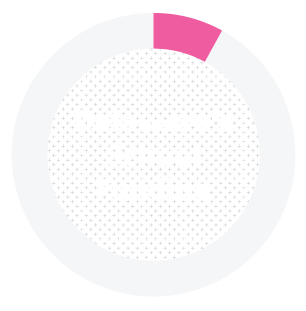
Based on analysis of Delaware state budget.
Is one of few states that does not provide sustainable funding or resources in its funding formula to support English learners and students from low-income families.
Delaware funds schools based on a count of students that districts conduct each year. This count is currently based on student attendance and takes place once a school year, typically around September 30.
Once the student count is complete and verified by the state Department of Education, the state takes the number of students in each building and converts them into "units."
A unit is the state resources needed to support a classroom such as salaries for teachers and school personnel, energy costs, building costs, etc. This means, that dollars are tied to the use of the specific "unit"—most often an individual teacher, administrator, or other staff position.
Source: The Education Trust
The current system
Students always generate the same fraction of a “unit” regardless of a student's need. Since units fund positions filled by individuals, each unit has a value on the state salary schedule based on years of experience and educational background. Therefore, the value of each student's funding will vary depending on the education and experience level of teachers in their district.
More simply put: Districts that attract and retain experienced, more highly paid teachers—which are often more affluent districts—get more money from the state.

Graphic not intended to show the actual number of students that equal one unit. Delaware code outlines the number of students that equal one unit. More information on this can be found under the “resource-based funding” section of the site.
Source: The Education Trust
Current Resource Inequities
Students from low-income families are far less likely to be enrolled in higher-level math in 8th grade than their higher income peers.
Source: U.S. Department of Education, National Assessment of Educational Progress, 2017 Mathematics Assessment.
Schools with more students from low-income families and students of color are more likely to have novice teachers and a higher turnover rate.
Source: DE Department of Education (2016-17), Data Request
Districts serving more students from low-income families tend to have lower average teacher salaries than districts serving primarily students from historically advantaged groups.
High-poverty schools have higher student-to-counselor ratios than low poverty schools.
Experts Say
Delaware's school funding system is inequitable.

Delware's Funding System
"Requires a one-size-fits-all approach to allocating the vast majority of resources between and within districts instead of recognizing that some schools serve students with greater needs and should have additional resources."
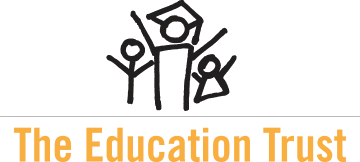

Ary Amerikaner Vice President for P12 Policy, Practice, and Research, The Education Trust
"By any of the available measures, Delaware is not ensuring that students in schools with high shares of low-income students have the same access to high-quality teachers as their peers in more advantaged schools."

Dr. Jesse Rothstein University of California, Berkeley
"By failing to make sufficient investments in effective educational interventions Delaware is trading off short-run budget “savings” for much larger long-run economic burdens."

Clive Belfield Queens College Department of Economics
"In Delaware, the high percentages of [low achievement among] disadvantaged students should be seen as the educational emergency that it is: substantial proportions of Delaware students are not on track."

Andrew Ho Harvard University
Change is a Long Time Coming
1940
Delaware school funding system created.
2004
Edits to special education formula to condense many unit categories down to three.
2015-2016
10+ executive / legislative task forces and public groups studying and recommending change, for example:
- LEAD Committee (2008) recommends a plan to allocate funds on a direct per-student basis.
- Wilmington Education Task Force (2008).
- Wilmington Education Advisory Committee (2015).
- Vision Coalition Student Success 2025 (2015).
- Senate Joint Resolution 4 (2015) Education Funding Improvement Commission.
- ***Education Equity Delaware (2016) created.
2018-2019
Lawsuit filed on behalf of Delawareans for Educational Opportunity and the NAACP Delaware against the State of Delaware January 2018 over inequitable funding system.
148th General Assembly passes SB172 in 2018 to require consistent reporting of school-level per pupil expenditure data.
Governor / legislature allocate FY18 Opportunity Grants to provide $1M in competitive grants to a handful of districts/charters.
Governor / legislature allocate FY20 Opportunity Grants to provide $60M (over three years) in grants for all students.
2020
May 2020: Court rules on county track that outdated property reassessment is unconstitutional. Trial date set for March 2021 to decide remedy.
October 2020: Settlement reached on state track of funding lawsuit , pending legislative approval.
2020 Election: 6 of 8 new legislators campaigned on education funding equity.
2021
SB 56 - codifies opportunity funding and gradual increases (signed 6/30/2021).
HB 86 - includes K-3 basic special education units.
HCR 24 - passed 6/30/21 - addresses need to improve and modernize DE funding system.
2022
AIR selected as the vendor for independent assessment.
HS 1 for HB 144 - changes to pre-K special ed (matches K-3 basic special education).
2023
HS 1 for HB 33 aligns the student-to-teacher ratios found in in pre-K basic special education with those in K-3 basic special education, adding additional resources to support high-need children.
HB 62 requires rolling property tax reassessment every five years. Release of independent assessment expected.

SB172
THE TRANSPARENCY BILL
We already have some laws on the books that can help us on this front. SB172 was meant to give the public a clear sense of how our school funding was being spent. While this law was implemented, its implementation could be improved.
State Funding Formulas

Did you know? Different states take different approaches to funding their public schools. Each state has its own unique twists, but they generally fund schools based on two basic formulas: student-based or resource-based.
Source: EdBuild
Student-based (or Foundation)
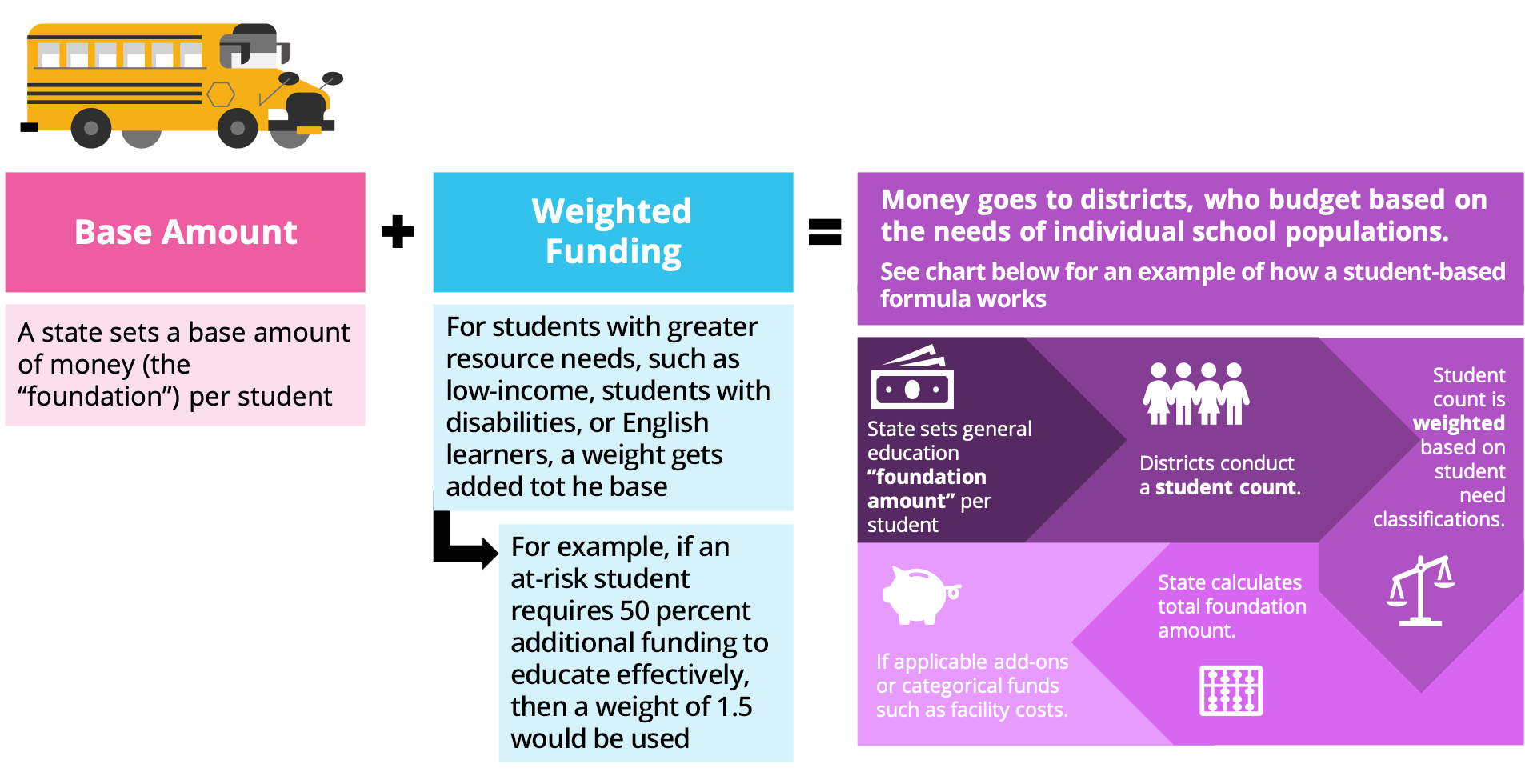
Student-based (or Foundation)
Students and their needs at the center of the funding calculation
Maximizes equity
Easy to establish
Easily adjusted to meet a state's/district's educational needs and economic circumstances
Provides districts with greater autonomy and flexibility
Built for transparency — simple to understand how much money a student should be getting and to hold the state and districts accountable
Resource-based
Delaware is only one of 6 states that uses a resource-based formula. Delaware’s resource-based formula looks like this:

Money is allocated mostly for specific staff positions (teacher units) based on student-to-staff ratios, e.g.:
- K-3 Regular Education: 16.2 students = 1 unit
- K-3 Basic Special Education: 8.4 students = 1 unit
- 4-12 Regular Education: 20 students = 1 unit
- 4-12 Basic Special Education: 8.4 students = 1 unit
- PreK-12 Intensive Special Education: 6 students = 1 unit
- PreK-12 Complex Special Education: 2.6 students = 1 unit
Unit is composed of 3 divisions:
- Division I (teachers) (~86%) value based on teacher's position on state salary schedule
- Division II (All Other Costs and Energy) (~5%)
- Division III (Equalization (~9%)
Opportunity Funding is separate and layers on top of the core allocation.
Resource-based
STRENGTHS & WEAKNESSES
Provides district with a predictable level of resources
Policymakers see what their education dollars are funding
Allow the state to control most of the education policy expenditure decisions
Student needs are not considered
Confusing and opaque, makes public accountability difficult
Do not allow districts to easily move funding around based on the district or students' needs
Requires the state to constantly adjust for non-teacher related costs of education (supplies, technology, testing)
Inflexible, difficult to adapt, and time consuming
Reflect a rigid and outdated education setting, in which classrooms consists of a single teacher, a certain number of students, and a set of needed materials
Does not adapt well to alternative structures of teaching like blended learning or co-teaching
Allocation of resource units depends on teachers' education and experience level
Leads to over-reliance of novice teachers in highneeds schools, and fewer actual dollars in these schools
How to implement a student-based system

Counting
Students

Choose
a base

Choose
weights

Accountability/
Transparency

Implementation
 Counting Students
Counting Students
 Counting Students
Counting Students

 Counting Students
Counting Students

 Choose a Base and Weights
Choose a Base and Weights
When choosing a funding formula, states need to balance between how much goes into the base and how much goes into the weight.
Typically speaking, setting a large base amount leaves a smaller available range for weights. While setting a smaller base amount means higher weights.
Delaware also utilizes Opportunity Funding, which allocates an additional $616 per multilingual learner and $616 per low-income student, or about 3% more per student. By comparison, Maryland funds 99% more for multilingual learners.
The most common categories of student need that states recognize:
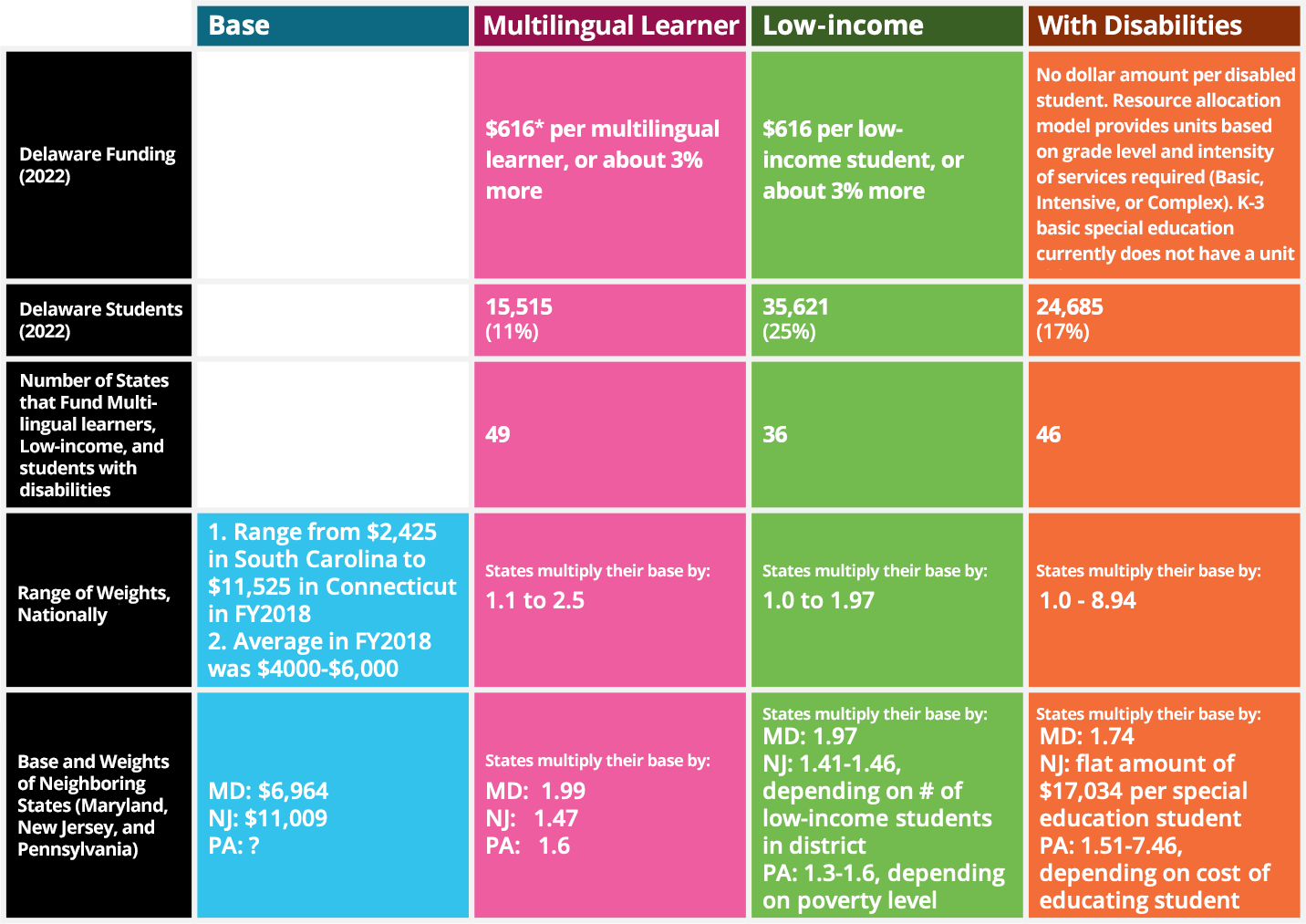
Sources: EdBuild and Delaware School Report Card
*As of FY22 budget
**The low-income measure is used for many different purposes and the state methodology changed in 2013-14 for allocation of funds, reporting, and accountability purposes. Currently, low-income status is determined by student participation in the Department of Health and Social Services assistance programs such as Temporary Assistance for Needy Families and the Supplemental Nutrition Assistance Program (TANF). Percentages may not total 100 due to rounding.
Regional Funding
Neighboring states including Maryland, New Jersey, and Pennsylvania have policies that provide annual additional funds for English learner students and students from low-income backgrounds as part of their funding formulas.
While Delaware does provide a few hundred dollars per English learner students and students from low-income backgrounds through Opportunity Funding, this is a small amount of money allocated separately from the inequitable funding formula that allocates most of the state's education dollars. Opportunity Funding represents only 3-9% of the overall education funding in the state.
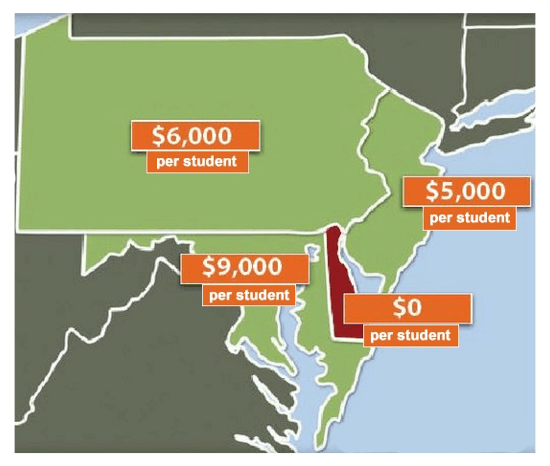

Source: The Education Trust
Transparency and Accountability: Building for the Long Haul
It has taken Delaware nearly 80 years to open up this policy discussion. We shouldn't wait another century to take another look. We should build in transparency and accountability so that we can ensure our tax dollars are going to where they can be used best.
States need accountability measures to ensure funding is spent on resources and evidence-based supports that will close opportunity and achievement gaps for high needs students.
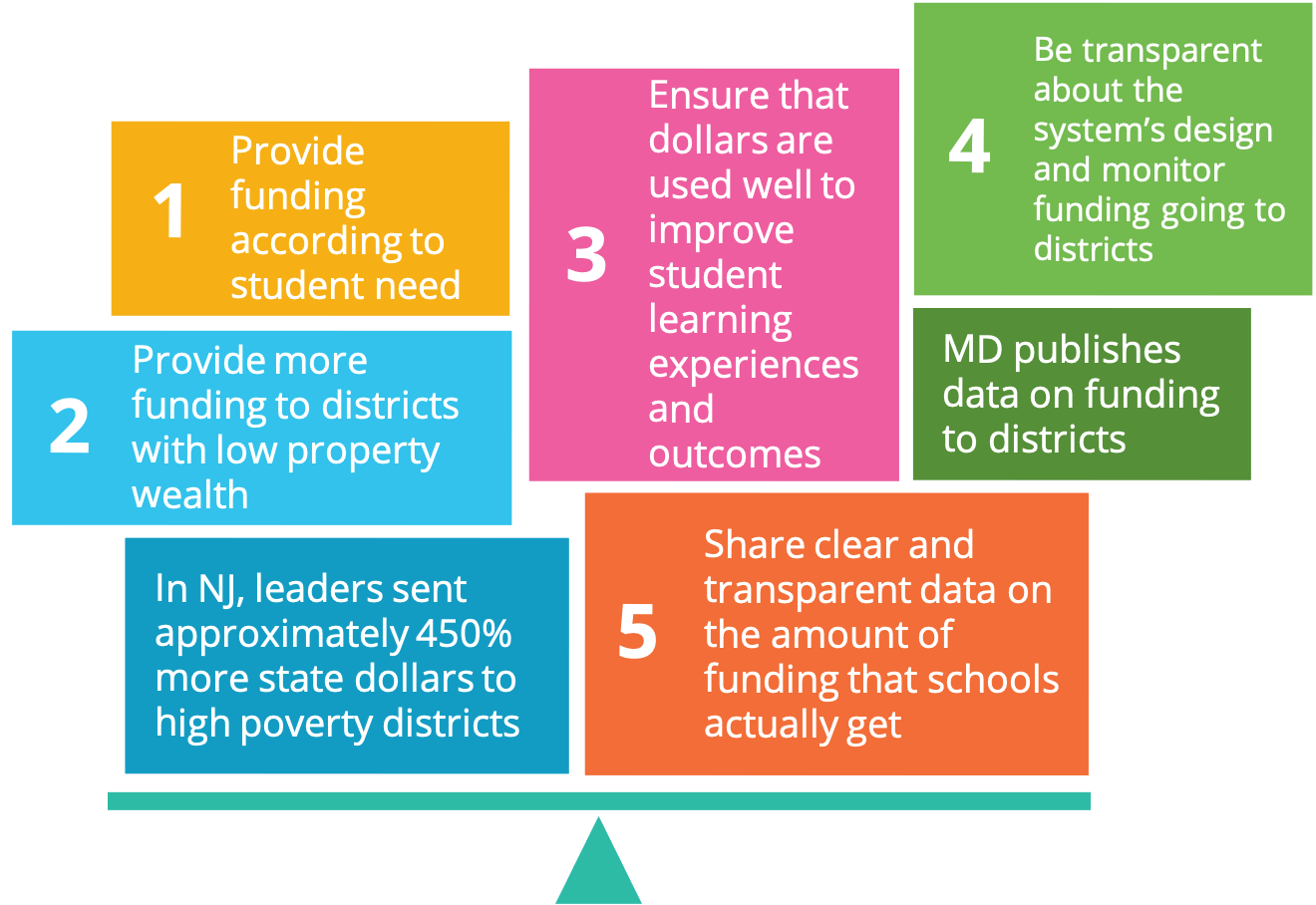
Implementation: We Can Do This
Every other state in the nation has modernized its system multiple times during the last eight decades. Some stakeholders have raised concerns about modernizing the funding system because it would be too unpredictable. The reality, as all other states have proven many times over, if adequate time is given to planning and transition, predictability isn’t a problem.
Transitions are possible. Schools can be brought in gradually through a multi-year phased in approach with adequate planning, notification, and communication. The transition for each school should take multiple years – allowing for sufficient planning and course corrections.
Costs include additional resources for students with needs, professional development for school and district leaders, potentially new accounting or technology systems, and technical expertise and capacity to support the transition process.

